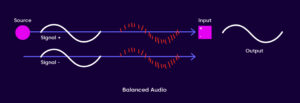In video and audio streaming, audio plays a prominent role in keeping your audiences engaged. It helps to enrich their viewing experience significantly. Hence, understanding the audio type that suits your streaming event best is essential. But how do you decide between balanced vs. unbalanced audio?
This post compares the key differences and functions of balanced and unbalanced audio. We also examine how they impact your sound quality. So, let’s dive in.
Key Difference between Balanced and Unbalanced Audio
Balanced and unbalanced audio cables are quite distinct regarding sound quality and noise resistance. Here’s a breakdown of their key differences:
- Noise Resistance: Balanced audio cables are designed to reduce the risk of picking up unwanted noise, making them great for maintaining a clear sound. On the other hand, unbalanced cables can sometimes pick up annoying hums or buzzes, particularly if used in certain places or situations.
- Signal Strength: Balanced audio is the way to go if you want a strong and clear audio signal without any unnecessary disturbances. It ensures that the sound remains sharp and pristine.
- Distance Matters: The difference becomes more noticeable if you’re working over longer lengths. Unbalanced audio cables are more likely to get noisy and have interference the further they stretch.
- Cable Construction: The way unbalanced audio cables are made, particularly the inclusion of the ground wire, can be a source of the extra noise. This construction contributes to their tendency to pick up interference.
In short, for cleaner and more consistent sound, especially over long distances, balanced audio is a superior choice, while unbalanced audio cables may work just fine in shorter, less demanding setups but come with a higher risk of noise.
What is Balanced Audio?
Balanced audio is a unique method for interconnecting audio gear. It crucially influences sound recording and production.

But why is it important? It’s important for its balanced interface. This interface reduces any chances of external noise. External noise can often sneak in through electromagnetic interference. With a balanced interface, this noise appears as common-mode voltages. The noise is then rejected by a differential device.
Balanced audio stands out for its use of specific types of cables and connectors. In most cases, they use shielded twisted-pair cables. These cables are paired with three-conductor connectors. XLR and TRS phone connectors are widely used due to their three-pin configuration.
Each balanced cable carries one audio channel. So, if you are dealing with stereo audio, you would need two such cables. This setup allows for clear and noise-free transmission of audio signals. Thus, it assures excellent balanced audio sound.
A common discussion point in the audio world revolves around waveforms in the balanced line. It’s typically thought that balanced audio requires equal and opposite waveforms in the two signal conductors. It’s not always the case. Many balanced devices actively drive just one side of the line. They do this at an impedance equal to the non-driven side. This impedance balance enables the following device’s input stage to reject electromagnetic coupling-introduced signals.
The balanced cable system is an effective method for clear and noise-free sound transmission.
How Balanced Audio Works
To understand balanced audio, you need to understand electrical currents and impedance. Let’s dive deeper into this fascinating process.
Audio Signal Transmission
The job of a balanced audio connection is to transport an audio signal from one end to the other. The signal sails smoothly along the balanced cable until it reaches its destination. This endpoint is referred to as the differential device. Here, the audio signal is allowed to pass uninterrupted.
Noise Cancellation
Its ability to handle noise – unwanted voltage from nearby electronics sets balanced audio apart. Balanced audio cables are engineered to distribute noise-induced voltage among their wires evenly. When this interference reaches the differential device, a unique process occurs. The device cancels out the noise, leaving only the original balanced signal.
Role of Impedance and Distance
Two essential attributes feed into this clever scheme:
- Impedance
- Distance.
The impedance of both wires in a balanced cable needs to be identical. This equal impedance allows for an equal distribution of the noise voltage. Further, by keeping both wires at the same distance from the noise source, noise voltage remains even across the wires.
Balanced Cables: XLR and TRS
XLR and TRS cables are frequently used in balanced audio connections. These balanced cables contain two conductors twisted together along their length, while an additional shield in these cables has little relevance to noise cancellation.
The versatility and identical nature of the conductors in the XLR and TRS cables ensure equal impedance. This alignment further plays a role in canceling noise while maintaining audio signal quality.
Cable Design in Balanced Audio
The conductors’ intentional twisting in the XLR and TRS cables ensures they occupy the same average position. Any noise voltage induced from nearby electronics will affect both wires equally.
When connected to a differential input device, XLR, and TRS cables promise complete noise cancellation. This is why balanced connections with such cables are highly sought for professional audio applications.
Types of Balanced Cables
There are two types of balanced audio cables: XLR cables and TRS cables.
XLR Cables

XLR cables are a staple in professional audio setups. They work effectively in transmitting balanced audio signals. Amazingly, they can send these signals up to 200 feet without any signal loss. If you look closely at an XLR connector, you will notice it contains three pins. These are not just any pins. One acts as a ground wire, while the other carries hot and cold signals. Every signal wire plays a significant role in supporting the best audio transmission. This unique setup enables XLR cables to have a balanced connection.
TRS Cables

TRS cables, or quarter-inch cables, are another must-have audio equipment. TRS, an acronym for Tip, Ring, Sleeve, is a robust, professional-balanced audio cable. It is best known for its ability to transmit mono (balanced) or stereo (unbalanced) signals. Each element – the tip, ring, and sleeve, contributes distinctly to the structure and performance of a balanced signal, providing a seamless audio experience.
Why Should You Use Balanced Audio?
Balanced audio becomes your top ally in producing top-notch audio quality. Here’s why.
Noise Cancellation
Balanced audio’s most powerful feature is its noise-cancellation capability. It ensures that any unwelcome external noise doesn’t interfere with your audio signal. It achieves this by evenly distributing the noise across two signal wires- balanced signals.
Greater Signal Integrity
A balanced output and input enable better signal integrity over long distances. So, balanced audio should be your go-to choice if you’re running audio over large areas.
Handle Unbalanced Inputs
Sometimes, you’ll come across gear with unbalanced inputs. Balancing these is typically a challenge. However, with a balanced circuit, unbalanced inputs are handled with ease. The balanced circuit accepts the unbalanced input and further boosts your audio quality.
What is Unbalanced Audio?
Unbalanced audio is another technology used to transmit audio signals. It works a bit differently than balanced audio.

This process involves an unbalanced cable. It is a form of wire used to carry signals. This cable usually contains only two conductors. One conductor carries the audio signal, while the other serves as a ground.
An unbalanced signal is the result of this process. This signal moves across the length of the cable from one device to another. With only two conductors, unbalanced audio has a more straightforward setup when compared to balanced audio. However, it has a few downsides.
Unbalanced connections inherit a higher level of susceptibility to noise interference. This can be a concern when your setup involves long cable lengths or if your recording environment has numerous electronic devices.
Unbalanced audio is commonly used in many consumer-grade equipment and applications despite potential drawbacks due to its simplicity and cost-effectiveness.
What are the Noise Factors of Unbalanced Audio?
Despite its simplicity and cost-effectiveness, unbalanced audio also comes with some distinct limitations. Noise interference is key to them. In unbalanced audio, these factors create noises.
Signal Interference
Unlike balanced audio, unbalanced audio carries the same signal across only two conductors. This simplicity causes signal interference. These interferences can distort the audio. This leads to an impact on your overall listening experience.
Long Cables
If your audio system relies on long balanced or unbalanced cables, it can invite unwanted noise. Unbalanced cables, in particular, often pick up more noise when offered a long distance to travel.
Radio Frequency Interference
Unwanted electromagnetic signals, such as radio frequency, can impact unbalanced audio. This interference affects the signal transmitted across the cable. This lead to disturb the audio quality.
Ungrounded Audio Components
The grounding of your audio components can influence the noise in an unbalanced system. Improperly grounded components can contribute additional noise, particularly noticeable in an unbalanced system.
Unbalanced Input
While balanced inputs can handle both balanced and unbalanced signals, unbalanced inputs can only manage the latter. When a balanced signal is fed into an unbalanced input, there’s a chance that the inverted signal gets lost. As a result, you only receive half of the audio information.
Different Connectors
Connectors used for unbalanced audio, often RCA or quarter-inch TS, differ from XLR connectors used for balanced audio. RCA connectors, for instance, are not designed to reject noise.
Power Cables
Power cables are another noise source for unbalanced audio, mainly if laid parallel or close to unbalanced audio cables. In a balanced system, the noise from power cables would be canceled out; an unbalanced one can cause interference.
Types of Unbalanced Cables
When discussing unbalanced audio, two types of cables commonly come into the picture:
RCA Cables

RCA cables are familiar in home entertainment systems. These cables, recognized by their red, white, and yellow plugs, transmit audio and video signals.
RCA cables contain two conductors- one for the audio signal and the other for the ground.
The signal conductor is usually in the center, surrounded by the ground or shield conductor. Despite their simplicity, RCA cables can exhibit susceptibility to noise over long distances.
Quarter-Inch TS Cables

Another cable type used in unbalanced audio systems is the Quarter-Inch TS Cable. The TS in their name is short for Tip Sleeve. The configuration includes the tip, which carries the signal, and the sleeve acting as the ground. These cables are commonly used for mono audio applications. Like RCA cables, Quarter-Inch TS Cables can be prone to noise disruption when used over longer distances.
Which is Better: Balanced or Unbalanced Audio?
Balanced audio is generally considered better. Here’s why:
- Noise Cancellation: Balanced audio is known for its ability to cancel out noise interference. It ensures better audio quality.
- Long-Distance Capability: Balanced audio maintains signal integrity over extended distances. That’s why it become a more reliable choice for professional setups.
- Versatility: Balanced audio can handle unbalanced inputs, demonstrating higher versatility.
However, remember that the better choice depends on your specific needs. Unbalanced audio can still be a good choice for short cable runs and less congested electronic environments.
The Impact of Balanced and Unbalanced Audio on Sound Quality
The cable type you choose can significantly impact sound quality. Balanced audio cables are designed for noise resistance. These can cancel out mismatched signals and unwanted noise that might sneak in along the cable. This ensures high-quality and clear audio.
On the other hand, unbalanced audio cables can sometimes fall short in managing external noise, especially over long distances. This can lead to a degradation in sound quality. However, unbalanced cables can still deliver satisfactory audio quality in less noisy environments or over short distances.









